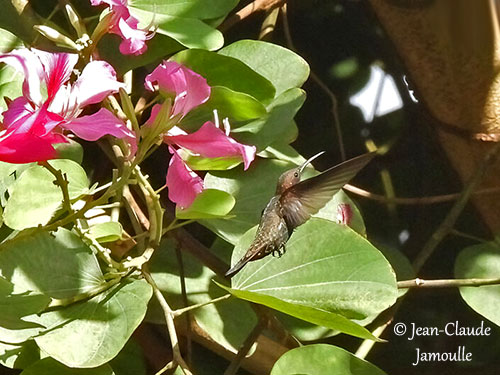
REPRODUCTION OF THIS SPECIES:
The Jamaican Mango breeds year-round, with peak between January and May.
The female builds a tiny cup-shaped nest with woven plant fibres. Green moss is added on the outside as camouflage. It is usually placed in shrub, bush or tree where it is secured to low branches by spider webs, about two metres above the ground. The nest is lined inside with soft plant fibres, animal hair and feather down.
The female lays two white eggs and incubates alone during 16-17 days. The male defends both nesting and feeding territories during this period.
The chicks are fed by regurgitation of insects by the female. They fledge about 24 days after hatching.
PROTECTION / THREATS / STATUS:
The Jamaican Mango has restricted range. It is common along the northern coastal areas, and it is also present in man-made habitats.
The species is not globally threatened and currently evaluated as Least Concern.
Fr: Mango de la Jamaïque
Ang: Jamaican Mango
All: Jamaikamangokolibri
Esp: Mango Jamaicano
Ita: Mango della Giamaica
Nd: Jamaicaanse Mango
Sd: jamaicamango
Photographers:
Jean-Claude Jamoulle
A la rencontre des Oiseaux
Dubi Shapiro
Dubi Shapiro Photo Galleries
Text by Nicole Bouglouan
Sources:
HANDBOOK OF THE BIRDS OF THE WORLD Vol 5 by Josep del Hoyo-Andrew Elliott-Jordi Sargatal - Lynx Edicions - ISBN: 8487334253
BIRDS OF THE WEST INDIES – by Herbert Raffaele, Kristin Williams et Tracy Pedersen – Helm – ISBN: 9780713649055
Neotropical Birds – Cornell Lab of Ornithology
THE AVIANWEB - Beauty of Birds (Sibylle Faye)
Jamaican Mango
Anthracothorax mango
Apodiformes Order – Trochilidae Family
INTRODUCTION:
The Jamaican Mango is endemic to Jamaica where it frequents forest edges, lowland country, gardens and plantations.
Its beautiful plumage shows shades of orange, blue-green and gold, and an iridescent magenta collar when observed in good light.
It typically feeds on nectar from numerous flowers and also consumes insects. It breeds year-round in a small cup of woven fine materials placed on tree branch.
The Jamaican Mango is described as a common resident, and the species is not globally threatened.

DESCRIPTION OF THE BIRD:
Biometrics:
Length: 11-12 cm
Weight: 8,5 - 9 g
The Jamaican Mango is a large, dark hummingbird. However, its plumage appears much brighter in good light.
The blackish plumage shows iridescent magenta collar around cheeks and neck sides. Shoulders and back are dull green-bronze. Wing-coverts and flight-feathers are glossy blackish-blue. On the tail, the central rectrices are dark bronze to dull black, whereas other tail feathers are metallic violet with dark blue band at tip.
The underparts are velvet-black.
On the head, the crown is dull greenish.
The black bill is long and slightly down-curved. The eyes are dark brown, surrounded by blackish eyering. Legs and feet are blackish.

Male and female are almost similar, but the female has dull green tinge on flanks, and the outer rectrices are tipped white.
The immature male resembles female but it has deep blue throat.
RANGE:
The Jamaican Mango is only found in Jamaica.
HABITAT:
The Jamaican Mango frequents a variety of open and semi-open lowland country, including forest edges, banana plantations and gardens. It can be seen from sea-level to 800 metres of elevation. It is rare in mangroves. It may occur at edges of wet forests between 900 and 1,500 metres in June-August.
CALLS AND SONGS: SOUNDS BY XENO-CANTO
The Jamaican Mango is usually rather silent, but we can hear series of sharp, raspy “tic-tic-tic…”
BEHAVIOUR IN THE WILD:
The Jamaican Mango feeds on nectar from numerous flowers, both native and introduced. It also takes insects while feeding on nectar. It especially feeds at cactus flowers and extracts insects from spider webs.

Like most Trochilidae, it is very territorial and defends strongly its foraging areas, performing aerial displays to chase other birds, large insects and bees.
In order to attract females, the male performs a U-shaped flight display in front of them. Males and females mate with several partners. The male does not take part in nesting duties.
The Jamaican Mango is resident in Jamaica, but it disperses to mid-elevations in June-August after the flowering season at higher altitudes.
The flight is very agile, especially when the bird if feeding at flowers and moves easily in all directions.
